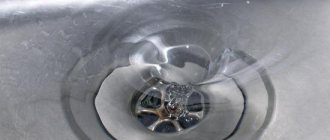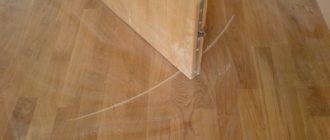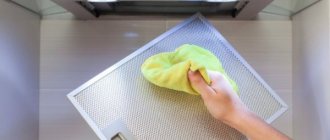In most cases, you can correct the situation on your own, using mechanical cleaning methods, special chemicals and even folk recipes.
In this article you will learn how to quickly and effectively clear a clogged kitchen sink at home.
Reasons for appearance
Before cleaning the drain, it is recommended to determine the cause of the blockage. The main ones include the following:
- Incorrect installation of plumbing. This could be, for example, installing waste pipes at the wrong angle.
- Foreign objects entering the drain that block and clog the pipe.
- Gradual accumulation of fat and other deposits in the pipes.
In cases where improper installation occurs, simply cleaning the pipes is not enough.
Video description
The effect of “Bagi Pothan” against plaque and pollution is clearly shown in this video clip:
"Mole" for blockages
"Mole" is a universal product for cleaning pipes. It contains potassium, sodium and acetic acid. This tandem removes heavy dirt and plaque. A significant advantage of the product is its low cost and effectiveness. In addition, it does not have an unpleasant odor and does not cause allergic reactions.
One application of "Mole" is enough for several months. To clean, pour a few spoons of the powdered product into the drain and leave it for 1 hour. After this, pour 1.5 liters of just boiled water into the pipe.
How to clean mechanically?
Mechanical cleaning methods are often used to remove blockages . These include the use of a glass, a plunger or a special cable.
Plumbing cable
The cleaning cable is often metal. It has a handle on one side and a split, hard end for cleaning on the other.
Application:
- The working part is lowered into the drain.
- By turning the handle, the cable is moved along the drain pipe.
- After removing the cable from the drain, there may be debris at the end of the cable that is obstructing the passage of water.
- Repeat the procedure several times.
- Check the quality of cleaning by pouring water into the sink.
- If necessary, I repeat the processing.
Mechanical cleaning can be supplemented by using special chemicals or home recipes.
You can watch how to work with the cable in the following video:
Cup
For small blockages, when water passes through, but not as quickly as usual, even an ordinary glass can help.
Principle of operation:
- take some water into the sink;
- lower the glass so that it covers the drain hole;
- press and then sharply move your hand with the glass up;
- repeat several times.
Cleaning using this method is similar to the principle of using a plunger, but it will not help deal with serious blockages.
plunger
It is advisable to have a plunger in the household - a simple tool that will help deal with fresh blockages.
Procedure:
- fill the sink with some water;
- install the plunger so that the drain is completely covered with the working nozzle;
- press the plunger with force and pull it sharply towards you;
- repeat the treatment several times in a row, even if the plug has already been removed.
In addition to the usual plunger, you can use pneumatic models.
Cleaning a sink with a plunger
If your kitchen sink is clogged, a primitive plumbing tool - a plunger - will help remove the blockage. This inexpensive gadget doesn't take up much space, but it comes in handy from time to time.
The operating principle of cleaning a sink with a plunger.
Operating principle of the plunger:
- the rubber bowl creates a tight connection with the surface of the sink;
- during forceful translational movements made by the handle, a water hammer occurs in the drain system;
- due to a pressure surge, the plug in the pipe is destroyed and pushed forward or backward along the line;
- water washes away the remaining clogs into the general sewer system.
The technology for clearing clogs with a plunger is so simple that anyone can handle it:
- Plug the overflow hole in the upper part of the sink with a wet cloth. It will block the air outlet from the system and increase the power of the water hammer.
- Press the edges of the rubber bowl tightly against the surface of the sink so that the drain hole is completely closed, and excess air comes out from under the plunger and a vacuum is formed.
- Forcefully make several movements with the handle up and down and sharply tear the plunger away from the sink. Repeat the manipulations several times until the plug is destroyed. Throw the debris coming out of the drain into a bin to speed up cleaning and prevent re-clogging of the system.
- Check the result - open the water tap and let a small amount of liquid flow through. If the water begins to drain normally, flush the drain with plenty of hot liquid for 5-10 minutes.
Using this method, you can break through the blockage without a plunger, replacing it with a thick glass glass or a rag. You need to act in the same way: press the object at hand to the drain, creating a tight connection, and sharply tear it away from the sink.
How to remove using folk remedies?
Even simple homemade recipes can help solve the clog problem. But it is better to use them in cases where the blockage is not severe. If the water does not drain from the sink at all, it must be scooped out before cleaning.
Boiling water
This is the simplest and most accessible.
Procedure:
- It is necessary to bring at least 1.5 liters of water to a boil.
- Pour boiling water into the sink, being careful to direct the stream into the drain.
- If the water begins to go away, then after 1.5 hours the procedure must be repeated. Otherwise, you will have to try another drain cleaning option.
This method is suitable for flushing out the blockage only if the pipes are not made of plastic. Otherwise, only water with a temperature of up to 70 degrees can be poured into the sewer. Failure to comply with this requirement may result in damage to the plastic pipeline.
Vinegar and soda against fat deposits
To clear clogs caused by food debris, especially greasy food, the baking soda and vinegar method can be used.
Procedure:
remove all water from the sink;- pour ½ pack of soda into the drain hole;
- pour in ½ cup vinegar;
- plug the drain hole to ensure that the chemical reaction takes place in the pipes and not on the surface of the sink;
- wait until the chemical reaction with the formation of foam is completed;
- pour 1.5 liters of boiling water (hot water) into the sink drain hole;
- Run cold water for 3 minutes to flush out the drain.
You can use cleaning with soda and vinegar as a preventive measure.
Hangover pills
If the blockage is not severe and you don’t have soda on hand, you can use effervescent hangover tablets. Alka-Seltzer will do.
Application is simple:
- In a saucepan, mix 2-3 tablets of the drug with a glass of vinegar.
- Quickly pour the foaming solution into the drain.
- Immediately plug the hole with a rag.
- After 10 minutes, turn on the water under pressure.
Alternative use of tablets:
- Grind and pour 2 tablets into the drain.
- Pour in a glass of vinegar.
- Plug the drain hole in the sink.
- Wait a few minutes for the reaction to pass.
- Run hot water.
Salt and soda
Kitchen drain pipes are susceptible to deposits from grease that gets into the pipes when washing dishes.
Application procedure:
- combine 4 tablespoons of salt with 2 tablespoons of soda in a container;
- pour two glasses of water;
- pour into the drain;
- plug the kitchen sink drain;
- stand for 10 minutes;
- run hot water.
This method cannot deal with old blockages.
Why do pipes get clogged?
In most cases, a clogged sink is caused by a person’s careless attitude towards plumbing. The problem appears in a number of the following cases:
- Throwing leftover food from plates into the sink when washing dishes. Gradually, the pipe becomes clogged and becomes covered with a greasy coating, which leads to the appearance of plugs and poor flow of liquid.
- Hair getting into sewer pipes when pets bathe in it.
- Sometimes blockages occur due to poor pipe installation. Because of this, kinks form on them, which prevent water from draining normally.
In old buildings, pipes become clogged due to rotting and a large coating of rust, which interferes with the flow of liquid.
Clogging occurs due to improper operation of the sewer system. For example, in case of untimely cleaning. You can tell when it’s time to clean your sink by the following signs:
- A constant unpleasant odor that does not go away after superficial washing with scented products.
- Slow water flow.
- Complete lack of drainage.
If a problem is discovered, you must immediately begin to fix it.
Stagnation of water in the sink due to an internal dirt plug Source mtdata.ru
How to quickly remove with special chemicals?
Various preparations can be used to clean kitchen drains. They are available in liquid form, in the form of granules in sachet.
The main point when choosing is to make sure that the product is suitable for the existing type of pipes and the expected type of contamination.
Bagi Schumanit
The drug, produced in Israel, is available in granular form . It allows you to completely eliminate the blockage in just 3 minutes, dissolving food residues and fat accumulations. Suitable for all types of pipes. Contains sodium hydroxide.
For the product to work, you need to remove the water from the sink. The contents of the sachet are poured into the drain and ½ cup of hot water is poured in. After 3 minutes, the sink is washed with a large stream of water.
Advantages:
- destruction of bacteria;
- elimination of odors;
- very high efficiency;
- fast action;
- dissolution of organic and inorganic substances.
Minuses:
- high price;
- caustic composition.
The average cost of a package is 150 rubles. The product is also available in gel form. Read reviews here, here and here.
Gel Mr.Muscle
The drug in gel form is an effective remedy that acts in a few minutes. If the plug situation is stubborn, the product may need more time to clear the drain.
Advantages:
- efficiency;
- ease of use;
- elimination of bacteria.
Minuses:
- caustic composition;
- price;
- high consumption of funds;
- for advanced cases it will take several hours.
Price – 300 rubles. You will find reviews here and here.
Tire Turbo
The gel is intended for cleaning pipes at home. The product is suitable for all types of pipes. Contains chlorine. A single treatment of one drain hole requires 250 ml of product.
Advantages:
- efficiency;
- works even when there is water in the sink;
- eliminates bacteria.
Minuses:
- price;
- high consumption.
Cost – up to 400 rubles. Reviews can be found here, here and here.
Special means
There are several types of cleaners available to remove clogs.
Liquid and gel
The most commonly used products are those available in the form of a gel or thick liquid.
"Sanfor"
Sanfor will help remove debris from the sink. This is a thick gel mixture produced specifically for removing blockages and cleaning sewer pipes. The dense structure of Sanfor allows it to penetrate deep into the pipe and get rid of plugs, even if there is water left inside. “Sanfor” is poured into the drain and left in it for an hour and a half. Then it is washed off with boiling water.
"Tiret Turbo"
Tiret Turbo is especially popular among housewives. This is a universal tool that will help clean metal and plastic drain pipes. Tiret Turbo is also used to prevent blockages. 200 milliliters of liquid are poured into the drain along with hot water. The procedure is repeated if there is debris left inside the sink.
Deboucher
An effective remedy that copes with both severe and minor blockages. The liquid contains chlorine, sodium, potassium and other active substances that help remove blockages in pipes. Among the disadvantages of Deboucher is that 500-600 milliliters of liquid are consumed for one-time cleaning of the sink.
Loose powder or granules
When cleaning sinks, you can use granular products or special powders.
"Bagi Pothan"
This powder is made from caustic soda and is used in dissolved form. You must use Baghi Pothan very carefully, as it has an unpleasant and pungent odor.
Experts advise wearing a gauze bandage and rubber gloves on your hands when using the powder. One-time use of the powder is enough to clean the pipe.
"Mole"
The most popular chemical used in everyday life is considered to be “Mole”. It is made from acetic acid, potassium and sodium hydroxide. The advantages of "Mole" include its effectiveness, low cost and ease of use. It is enough to use the “Mole” once to clean the sink for a long time.
See also
30 best products for cleaning the refrigerator inside and out, what and how to eliminate the smell
Chirton "Clean drains"
A highly effective product produced to remove blockages inside pipes. One bottle is enough for 2-3 uses. Chirton does not work immediately, so it is necessary to flush the pipes only 20 minutes after using the drug.
Instructions for use
When using most cleaning products, perform the following sequence of actions:
- Pouring the composition into the drain. To begin with, the product is poured into the sink. If necessary, mix it with warm water so that the mixture is not thick.
- Cleaning the sink. 10-30 minutes after using the cleaning compounds, the pipe must be washed with water.
Disassembling the siphon
Directly under the kitchen sink there is a siphon - a simple structure that can be disassembled. This method is very effective when the cause of the blockage is in the siphon. After all, the water draining from the sink first enters it.
Procedure:
- Free up space under the sink.
- Place a bucket under the siphon.
- You need to unscrew the plastic nuts holding the siphon. Or you can unscrew only the siphon sump nut. In this case, the entire contents of the sump will flow into the bucket.
- Clean and rinse the removed part.
- You can also disconnect the corrugated pipe leading to the drain and wash it as well.
- Install all elements in their original place.
If partial dismantling of the siphon is not possible, it is removed completely, disconnecting it from the sink and drain pipe, and then washed and cleaned in a separate container.
The procedure for cleaning the siphon can be seen in the video:
Vacuum cleaner
Some people do not want to use cleaning products and prefer to clear clogs with a regular vacuum cleaner. This method will help if the pipes are slightly clogged. A vacuum cleaner with an air blowing function is suitable for cleaning. Before blowing, carefully wrap the vacuum cleaner tube in a thick rag, after which it is installed in the drain hole. Then the device turns on the blowing mode to push through the blockage.
Features of cleaning plastic pipes
Cleaning plastic pipes requires special care. Despite the strength, the material from which the drainage system is made is susceptible to mechanical damage and exposure to very high temperatures.
The inner surface of the pipes is quite smooth; with proper installation, blockages in such a system occur less frequently than in cast iron drainage systems. This is explained by the fact that plastic is not prone to corrosion and the adhesion of various substances to the surface .
But during operation, food particles that fall into the kitchen drain can be deposited, causing a blockage. The best options for cleaning approaches are the use of a plunger, the use of home and special products.
Preventive measures
Prevention measures are not complicated , but thanks to them, problems with water drainage will occur much less frequently:
- It is advisable to install a special sieve in the sink drain holes (both in the kitchen and in the bathroom). It will help prevent large particles and hair from entering the drain.
- You should regularly pour boiling water down the drain (for plastic pipes - just hot water). This will prevent sediment from accumulating on the surface of drainage communications.
- You should not clean food residues, construction mixtures, water after washing shoes, etc. into the sink.
Call a plumber
In situations where you cannot cope with the blockage on your own, you will have to turn to the help of a plumber.
Also, the intervention of a specialist will be needed when the problem with blockage is related to the drainage system in the apartment or to the riser in the house.
The cost of the service is determined by the complexity of the problem and the necessary cleaning work. If replacement of units or individual parts is required, the customer pays for them separately. On average, in the capital, clearing a clogged sink will cost from 500 rubles.
How to disassemble and clean the sink siphon - the simplest and most reliable way to remove a blockage
If you have already tried to break through the blockage in the sink using folk or chemical remedies, but the water still stands or drains slowly, then most likely you need to clean the siphon. Fortunately, even a child can take it apart. All you need is: 15 minutes of free time and a screwdriver or coin.
Step 1. Unscrew the nut that is located above the siphon reservoir and carefully remove it.
- It is advisable, before disassembling the siphon, to place a basin under it for occasional puddles and to collect dirt. And, of course, don't forget to wear rubber gloves.
Step 2. Hold the siphon in one hand, and with the other hand disconnect the drain hose, unscrewing the nut between them. Next, we move the siphon and drain hose to the side (for example, into a basin), and at the same time remove the dirt that falls out of them.
Step 3. Now unscrew the drain grate in the sink using a screwdriver or coin (most modern grates can be unscrewed with a coin).
Step 4. Unscrew the top nut on the remaining pipe and take it out of the sink along with the already unscrewed drain grate. Hooray! The siphon is disassembled.
Step 5. Wash all the parts. To thoroughly clean the siphon, unscrew the flask from it.
Step 6. We assemble the siphon in the reverse order: install the drain grate and pipe, secure it with a nut, then assemble the siphon, connect it to the drain hose and, finally, screw it to the pipe. Ready! We check whether the blockage has been cleared and are proud of ourselves.
Prohibitions when cleaning
When starting to clear a clogged kitchen sink, you need to remember a number of prohibitions:
- Do not begin to break the plug while there are dishes in the sink. It and food must be removed in advance.
- You should not get to work without rubber gloves. This is especially important when using purchased chemicals, since such products have an aggressive composition.
- Do not use chemicals that are not intended for this purpose to clean pipes. They can emit toxic fumes and even damage pipes.
- You should not pour all the products that come to hand down the drain at the same time, as this can harm communications.
Chemistry comes to the rescue
The choice of chemicals for cleaning sewer pipes is extensive - in any hardware department you will find something that you can afford.
The assortment is large - gels, granules, powders. In such chemical compositions, the active substance is either an alkali or an acid. Whatever you choose, the first thing you should take care of is your own safety.
Aggressive chemistry will not improve your health if you accidentally drop it onto your palm, so let's talk about precautions.
We open the windows, put on a protective mask and goggles, and wear thick rubber gloves on our hands. If the windows of your house face different sides and it is possible to provide cross ventilation, do it.
Never use two different cleaning chemicals at the same time, even with the best intentions - compounds can form that will harm not only the sewer system, but also you.
If you are a resident of an old housing stock with cast iron pipes, this method is not suitable for you. If you have plastic pipes, you should not increase the contact time of chemicals and elements of the sewer system prescribed by the manufacturer. By the way, the label should say that it is intended for your type of pipe.
If the blockage problem has been acute for quite a long time, perhaps one chemical filling will not be enough for you. Therefore, wait the allotted time (read the label), spill hot water and use the services of a trouble-free plunger. Together, both methods will definitely help you!
What if there are children and animals in the house? And you don’t want to use aggressive chemicals? Isn't there a more gentle way? There are such recipes, and we will definitely tell you about them.
Prevention measures
To prevent blockages from recurring, preventive measures should be taken into account:
- Periodically you need to rinse the sink by running boiling water or hot water if the pipes are made of plastic;
- It is necessary to insert a special strainer into the kitchen sink drain, which will prevent large fragments of food waste from getting into the drain;
- You should not shake bread crumbs into the sink, wash off tea leaves, or pour out greasy liquid, as all this will stick to the pipes and accumulate in the siphon.
Dismantling the pipe and siphon
In some cases, the blockage can be removed without the use of folk remedies or aggressive chemicals. To improve water flow, it is enough to remove the siphon and clean it mechanically.
The classic siphon model has several details:
- a flask-shaped reservoir - acts as a water seal, preventing unpleasant odors from escaping from the sewer system;
- drain pipe - adjacent to the drain hole of the sink;
- outlet pipe - connects to a corrugation or waste pipe;
- nuts;
- sealing gaskets.
Most often, the problem is that a fatty coating forms inside the flask or on the walls of the pipes, which prevents the normal drainage of water. All parts of the plumbing fixture can be easily dismantled and assembled just as easily, so you can clean the siphon yourself.
Dismantling method:
- Put rubber gloves on your hands.
- If the space under the sink is poorly lit, prepare a flashlight.
- Remove all foreign objects from under the sink.
- Place a basin or bucket under the sink.
- Carefully unscrew the nut connecting the flask to the drain pipe.
- Disassemble the connection of the outlet pipe with the corrugation.
- Remove the siphon and clean it with any available object, such as a thin brush or an old toothbrush. Rinse with hot water.
- If the siphon is not clogged enough to impair the flow of wastewater, clean the drain with a plumbing cable.
- Reassemble the structure in reverse order.
- Check the tightness of the connections - place dry paper or cloth under the siphon and turn on the water. If no wet spots appear on the substrate during the day, then the assembly was carried out correctly. A leaking connection will have to be disassembled and reassembled, ensuring that the sealing gaskets are installed correctly.
Pipe and siphon diagram.
The siphon can cause an unpleasant odor in the kitchen when the owners are away for a long time and do not use the sink. In such cases, the water in the flask completely evaporates and opens the way for foul-smelling gases from the sewer.
To solve this problem, just pour 1-1.5 liters of water into the sink. When leaving home for a long time, you need to pour a few drops of sunflower oil into the drain hole: the film floating on the surface of the water seal will not allow moisture to evaporate.
Tips from the professionals
Tips from plumbers will help you better cope with cleaning your kitchen sink:
If clogged pipes are a frequent and regular occurrence in your home, then it makes sense to purchase a plumbing cable. It is inexpensive and will last for many years. Having a comfortable handle at one end is a must.- If the problem with blockages is related to installation errors, it is recommended to correct them, otherwise blockages will occur constantly.
- If the blockage was broken through with a cable, it must then be cleaned of dirt and dried. Store in a dry place, rolled up.
- It is better to clean drains in the kitchen with the window open so that there is an influx of fresh air, since in most cases the smell will be unpleasant.
- The combination of mechanical and chemical methods makes pipe cleaning more effective. For example, use a plunger, and then use special household chemicals.
If you are interested in how to clear a clog in a pipe, sink or toilet, take a look at this section.
TOP 5 radical ways to ELIMINATE CLOGGES in a sewer pipe
When folk remedies do not help, you can resort to a mechanical method of removing clogs in drain pipes. There are several options for mechanical action on the accumulation of dirt and grease in the sewer. Let's look at the 5 most popular methods.
No. 1. By cable
Cleaning pipes using a cable
How to break through a blockage in a pipe? For punching you will need a special plumbing cable. It is used in cases where the plug has accumulated far from the drain hole. It is also good for removing blockages from bendy parts of pipes. Using a cable, it is easy to remove the accumulation of fat and debris or break the plug and free the pipe from contaminants.
How to break through a blockage with a cable - instructions:
- Removing the siphon. It is impossible to remove dirt from the pipes with a cable without first removing the siphon. Only after its dismantling will it be convenient to get to the sewer.
- Cleaning with a cable. Place the cable in the pipe and move it clockwise and move it forward. Movements should be smooth, not abrupt. If there is resistance along the path of the cable, you need to twist the cable until it passes the obstacle and moves on.
- Flushing the drain. After the plug is destroyed, you need to remove the cable, then replace the siphon, turn on the water and flush the drain.
Video instructions for removing blockages with a cable:
A special cable is sold in plumbing stores. But you can make the device yourself from an ordinary metal cable.
The master class on how to make it is quite simple:
- You will need a regular flexible, not very thick cable.
- One end must be bent and fluffed.
- A ring is attached to the opposite end of the cable. With its help it will be easy to scroll the cable.
- A small piece of plastic pipe is placed in the middle of the cable. This will be a kind of handle that will be convenient to hold the device while working. If there is no plastic pipe, the cable can simply be wrapped in any rigid material and secured.
This simple device is multifunctional. It can be used for a variety of jobs: cleaning drain pipes, water supply elements, heating, and even cleaning chimneys.
No. 2. Cleaning with a vacuum cleaner
Clearing a clogged pipe with a vacuum cleaner
A regular vacuum cleaner will help solve the problem. The only condition is that the device must be equipped with a blowing function. The end of the hose is wrapped in fabric with a not too tight weave. The material must be firmly attached with tape, thread or tape. The hose rests tightly against the drain hole at an angle of 90°C. The device turns on at maximum power. The air pressure will push out the resulting plug. This method will only be effective if the contamination has accumulated no further than 1 m from the drain hole.
No. 3. Using a plunger
Clearing a clog using a plunger
A plunger is a special device for clearing water drainage in sinks. The appearance of this plumbing tool is familiar to many. It is a rubber cup-shaped attachment mounted on a wooden handle.
A plunger is most effective when a blockage in a pipe in the house has formed close to the drain hole. The further away the plug is, the less effective the plumbing tool is. Plungers can be pneumatic or mechanical. The nozzle can be made in the form of a washer or a cone.
Removing blockages in sewer pipes with a plunger:
- Dry the sink from water. But it is necessary to leave a small amount of moisture directly around the drain hole.
- Plug other drain holes. If there are other sinks or bathtubs in the house, then it is necessary to close their drain holes with a stopper. This creates good pressure in the pipe.
- Install a plunger. The rubber bowl of the plunger should completely cover the drain hole.
- Pump the plunger. After installing the plunger, you need to make about 10 vigorous movements up and down. In this case, the bowl of the plunger must not be torn off the surface of the sink. Then quickly remove the plunger. Water with particles of the destroyed mud plug will begin to flow into the drain hole. When water fills the drain hole, you must quickly repeat the procedure, preventing the liquid from going down again.
Video instructions for clearing a clog with a plunger:
A sign that everything has been done correctly will be the complete drainage of water into the hole, along with the dirt. If this does not happen, then the procedure should be repeated several times. Perhaps the reason is that there are too many clusters and they could not be destroyed at once. If after the work done the water has completely gone down, then the cleaned pipes are washed with tap water. For preventive purposes, you can use a ready-made pipe cleaner. We will talk about them below.
No. 4. Dismantling and cleaning the siphon
Dismantling and cleaning the siphon
A clogged siphon is the most common reason for “obstruction” of water from the sink. To fix the problem, you need to disassemble the siphon and free it from contaminants. This is done as follows:
- Place a piece of fabric under the siphon. The material must absorb water well.
- Place a basin under the sink. Water will flow into it.
- Unscrew the solution nut that secures the siphon tube.
- Remove the siphon and clean it of dirt. This can be done with a brush or dish brush.
- Rinse the siphon under running water.
- Pour a mixture of vinegar and soda into the pipe that is connected to the sewer. A reaction will take place that will corrode the contaminants on the pipe walls. To consolidate the result, pour another 150 ml of vinegar into the pipe. Do the same manipulations several more times.
- After 15-20 minutes, pour 2-3 liters of hot water into the pipe. After this you need to wait 5 minutes.
- Place the siphon in its original position. Tighten the lock nut.
Disassembling and cleaning the siphon from blockages with your own hands:
If you follow these instructions, you can deal with the accumulation of dirt and grease in the pipes in just one time.
No. 5. Hydrodynamic method
hydrodynamic method of cleaning sewer pipes
Clearing blockages in pipes using the hydrodynamic method is used when none of the above methods have proven effective. But to carry it out, plumbers with special equipment are hired. The essence of this method is to use water that is supplied under high pressure.
This is done using a special machine. It supplies water under high pressure. A hose with nozzles of different sizes is connected to the device. The work takes place in 2 stages:
- At the first stage, the plug is broken through and preliminary cleaning of contaminants is carried out. For this purpose, a hose with large nozzles, called punching nozzles, is used.
- The second stage involves more thorough cleaning. In this case, smaller nozzles with a brush-shaped nozzle are installed at the end of the hose.
This method is effective for removing large, heavily compacted layers of grease and dirt from pipes.
Removing the clog... Alka-Seltzer
If there is suddenly no soda in the house, but there is Alka-Seltzer, then it can also clear a moderately clogged siphon. By the way, this product has another bonus - the unpleasant smell from the sink will disappear.
- Throw a couple of Alka-Seltzer tablets into the drain hole, and then pour in 1 cup of 9% vinegar.
- After 2 minutes, run the hot water full blast to help push through the dirt.
It's easier than ever to prevent blockages
It is enough to encounter a blockage once in order to strictly follow the rules for preventing such an unpleasant situation in the future. A strong sewer odor and the inability to use the sink effectively are all characteristics of a clog. How to avoid it?
Above, we have already convinced you of the need to purchase a drain mesh; this is a mandatory item in the program for preventing garbage plugs in the kitchen sink.
Let's talk about a food waste shredder, which can be purchased at construction supermarkets. This is certainly not the cheapest purchase, but it is completely worth every dollar invested.
Unfortunately, we are lazy and do not carefully clean the leftover food into the trash container. We make our work easier by simply rinsing the plates under running water before washing or loading them into the dishwasher.
After purchasing a shredder, you will forget the very word “clogging”, since now this indispensable assistant, working silently under the siphon, will deal with all waste quickly and efficiently.
If purchasing a household waste shredder is not in your immediate plans, let's talk about preventing blockages . It is enough to pay attention to the cleanliness of the kitchen sink drainage system once a week, and you will no longer have to deal with clearing garbage plugs in the drain.
So, every week make it a rule to pour several liters of boiling water into the drain for half an hour, then be sure to open the hot water tap. You can also use a plunger periodically to break up the deposits into small pieces.
Vegetable oil and other fats should not be drained into the drain hole of the sink; if, due to a misunderstanding, this does happen, the most correct action is to run hot water to clean the walls of the sewer elements from deposits. It will also be effective to use any home method for cleaning drains (see the exact recipes above in the article).
Thus, we see that we do not need any Herculean efforts to avoid clogging in the kitchen sink. Quite simple rules for caring for siphons and sewers will ensure uninterrupted and efficient operation of water supply and sanitation in your home.
If you couldn’t cope with the blockage on your own (using several different suggested methods), then it’s time to call a plumber. The cause of the problem can probably only be solved by professionals. Modern specialized equipment works wonders, so don’t despair, but start taking action.
We wish that only pleasant aromas settle in your home, trouble-free days reign, and the space is filled with that same indescribable atmosphere of comfort. Let your wonderful home help you start the day cheerfully and cheerfully, and end it in a relaxed atmosphere in a pleasant conversation with your family. Please accept our wishes for a great mood and well-being!











